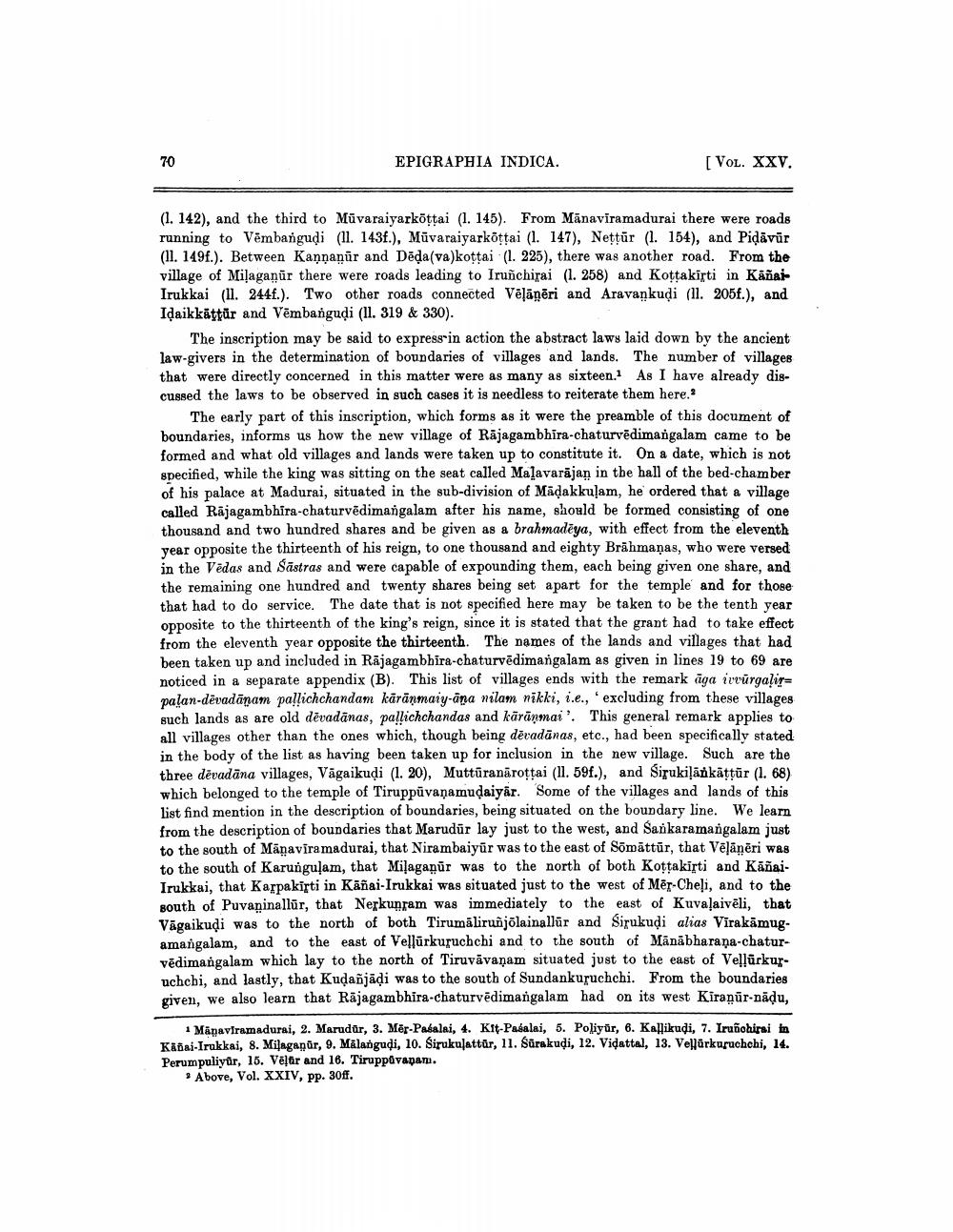________________
EPIGRAPHIA INDICA.
[Vol. XXV.
(1. 142), and the third to Mūvaraiyarkottai (1. 145). From Mānaviramadurai there were roads running to Vēmbangudi (11. 143f.), Mūvaraiyarkottai (1. 147), Nettür (1. 154), and Pidāvūr (11. 149f.). Between Kannanūr and Dēda(va)kottai (1. 225), there was another road. From the village of Milaganūr there were roads leading to Iruñchirai (1. 258) and Kottakirti in KañarIrukkai (1l. 244f.). Two other roads connected Vēlāņēri and Aravankudi (11. 205f.), and Idaikkättür and Vēmbangudi (11. 319 & 330).
The inscription may be said to express in action the abstract lawy laid down by the ancient law-givers in the determination of boundaries of villages and lands. The number of villages that were directly concerned in this matter were as many as sixteen. As I have already discussed the laws to be observed in such cases it is needless to reiterate them here.
The early part of this inscription, which forms as it were the preamble of this document of boundaries, informs us how the new village of Rājagambhira-chaturvēdimangalam came to be formed and what old villages and lands were taken up to constitute it. On a date, which is not specified, while the king was sitting on the seat called Malavarājan in the hall of the bed-chamber of his palace at Madurai, situated in the sub-division of Madakkuļam, he ordered that a village called Rājagambhira-chaturvēdimangalam after his name, should be formed consisting of one thousand and two hundred shares and be given as a brahmadēya, with effect from the eleventh year opposite the thirteenth of his reign, to one thousand and eighty Brāhmaṇas, who were versed in the Vēdas and Šāstras and were capable of expounding them, each being given one share, and the remaining one hundred and twenty shares being set apart for the temple and for those that had to do service. The date that is not specified here may be taken to be the tenth year opposite to the thirteenth of the king's reign, since it is stated that the grant had to take effect from the eleventh year opposite the thirteenth. The names of the lands and villages that had been taken up and included in Rājagambhira-chaturvēdimangalam as given in lines 19 to 69 are noticed in a separate appendix (B). This list of villages ends with the remark āga ivvürgalira palan-dēvadānam pallichchandam karānmaiy-āna nilam nikki, i.e., excluding from these villages such lands as are old dēvadānas, pallichchandas and kārāņmai'. This general remark applies to all villages other than the ones which, though being dēvadānas, etc., had been specifically stated in the body of the list as having been taken up for inclusion in the new village. Such are the three dēvadāna villages, Vāgaikudi (1. 20), Muttūranārottai (11. 59f.), and Sirukiļāňkättür (1. 68) which belonged to the temple of Tiruppūvaņamudaiyār. Some of the villages and lands of this list find mention in the description of boundaries, being situated on the boundary line. We learn from the description of boundaries that Marudur lay just to the west, and Sankaramangalam just to the south of Mānavira madurai, that Nirambaiyūr was to the east of Somāttür, that Vēļānēri was to the south of Karunguļam, that Milagapūr was to the north of both Kottakirti and KāñaiIrukkai, that Karpakirti in Kāñai-Irukkai was situated just to the west of Mēr-Cheļi, and to the south of Puvaninallür, that Nerkunram was immediately to the east of Kuvaļaivēli, that Vāgaikudi was to the north of both Tirumāliruñjõlainallūr and Sirukudi alias Virakāmug. amangalam, and to the east of Velļūrkuruchchi and to the south of Mānābharana-chaturvēdimangalam which lay to the north of Tiruvāvanam situated just to the east of Vellürkuruchchi, and lastly, that Kudañjādi was to the south of Sundankuruchchi. From the boundaries given, we also learn that Räjagambhira-chaturvēdimangalam had on its west Kiranür-nādu,
1 Mánaviremadurai, 2. Marudur, 3. Mēr-Pabalai, 4. Kit-Pasalai, 5. Poliyür, 6. Kallikudi, 7. Iruñohirsi in Kibai-Irukkai, 8. Milagan ür, 9. Mälangudi, 10. Sirukulattur, 11. Surakudi, 12. Vidattal, 13. Velúrkuruchchi, 14. Perumpuliyür, 15. Vēļfir and 16. Tiruppuvapan.
Above, Vol. XXIV, pp. 30ff.




